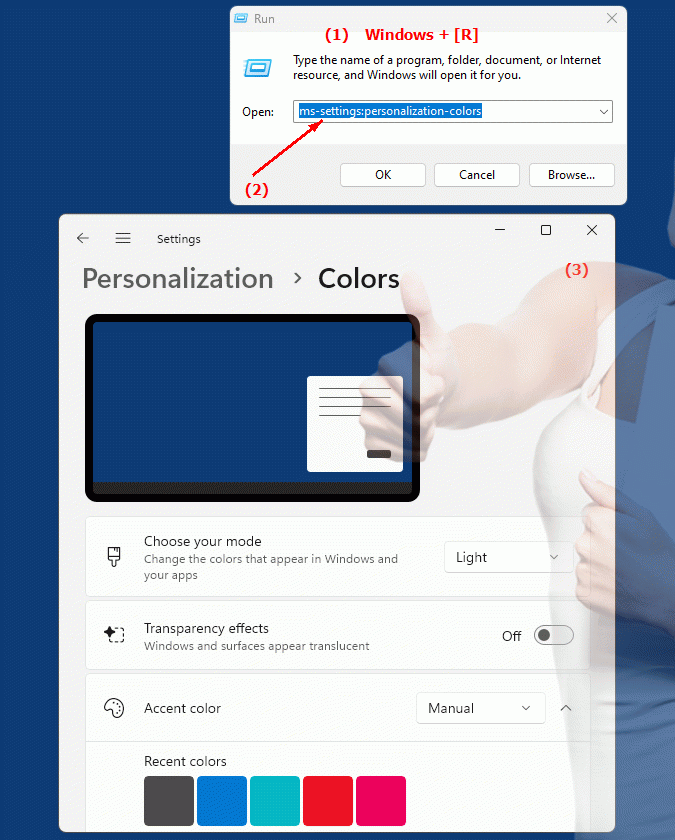The URL and protocol URL "ms-settings:personalization-colors" opens the Colors settings in the Personalization pane of Windows 10 und 11 .
This page allows users to customize the color scheme of the user interface, including choosing accent colors, adjusting transparency effects, and selecting themes. Here is a detailed description of the availability of this feature in different versions of Windows and the corresponding build numbers:
1. ms-settings:personalization-colors
2. Availability under Windows
3. Other useful commands in the Windows settings
1. The Command ms-settings:personalization-colors
1. Activate the Run menu by pressing Windows R.2. Simply enter the command: ms-settings:personalization-colors
(Use the command for a desktop shortcut as well.)
3. Press [Enter] or the OK button to execute the action.
(... see Image-1 Point 1 to 3)
You can now use the settings described above in your Windows 10, 11 or 12.
This will address the following questions and challenges.

1b. This will address the following questions and challenges.
How do I change the accent colors on my Windows desktop?Can you tell me how to set the transparency effects in Windows color settings?
I want to customize my Windows user interface, but I don't know where to go. Can you help me?
How do I configure the user interface color scheme in Windows?
I heard that you can also select themes in the Windows settings. How do I do that?
Can you show me how to change the color settings in the Windows Personalization panel?
I'm looking for a way to tweak my PC settings and try a different color scheme. Do you know how to do that?
Are there differences in the availability of this feature in different versions of Windows, and if so, what build numbers does it apply to?
I want to help my friend adjust the color settings on his PC. Do you know where I can explain this to him?
2. Availability in Windows 10, 11 and 12 and the corresponding build numbers.
Windows10
- Availability:
Available in Windows 10 since the first release and continuously improved, Color Settings offers a variety of options for customizing user interface colors, including choosing accent colors, adjusting background colors, and managing transparency effects.
- Build number:
The "ms-settings:personalization-colors" URL is available starting with Windows 10 version 1607 (Anniversary Update). This version was released on August 2, 2016. Users can use this URL to go directly to the Colors settings where they can configure their color schemes and transparency effects.
Windows11
- Availability:
In Windows 11, color settings remain intact and have been adapted to the new design. Windows 11 offers a modernized user interface and additional color options that are adapted to the new design philosophy.
- Build number:
The "ms-settings:personalization-colors" URL is available in Windows 11 starting with version 21H2 (Initial Release), released on October 5, 2021. Starting with this build, users can adjust color settings directly from the provided URL, taking into account the new design philosophy of Windows 11.
Windows12
- Availability:
In Windows 12, the color settings customization feature will continue to be supported, with possible enhancements and improvements tailored to the new version of the operating system. The basic functionality of the "ms-settings:personalization-colors" URL is expected to be retained, with possible integration of additional customization options or design changes.
- Build number:
The exact build number for the feature's introduction in Windows 12 will be specified after the first builds are released. However, the feature is expected to be supported starting with the early builds of Windows 12 that are available.
Summary
The "ms-settings:personalization-colors" URL is available in Windows 10 starting with version 1607 (build 14393) and remains available in Windows 11 starting with version 21H2, as well as in Windows 12. It provides a centralized way to customize the user interface color schemes, including accent colors, transparency effects, and background colors. The exact build number for Windows 12 will be provided after the initial releases of the version, but the functionality is expected to be included in the early versions of the new operating system.
